Because much of their native grassland habitat has disappeared, the lesser prairie chicken now occupies just 17 percent of its original range. Here's what Pheasants Forever is doing to save these boomers of the southern plains.
Story by Brianna Randall
Pictures by Chad Love
It’s dawn on the prairie, and the grass-scented spring air is alive with birdsong and butterflies. Rocky red buttes rise through the undulating waves of green, while tall oaks shade winding streams. These are America’s Great Plains, which cover one-third of the country and support grazing animals, burrowing critters and millions of birds.
As the sun peeks over the grass on a mild spring morning, bubbling sounds ring across the land — lesser prairie chickens are “booming.” Males with dashing yellow eyebrows call in the plainer brown-and-white-striped females by inflating balloon-like red pouches on their necks. These grouse also stomp their feet, flutter-jump and lunge in hopes of luring in one of the hens. Alas, the ladies are picky: they often visit two or three dancing grounds before selecting their mate.
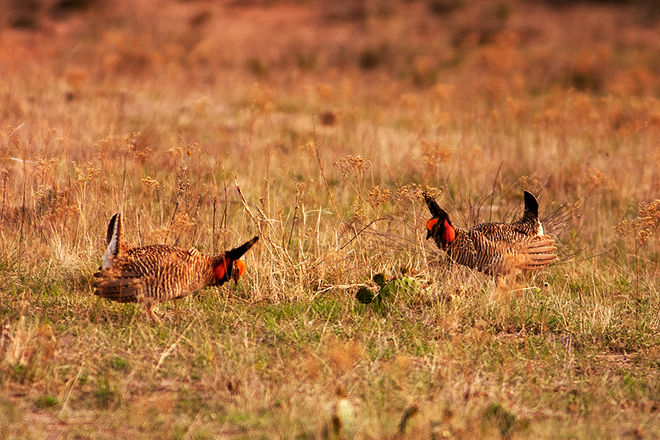
DIMINISHING HABITAT
Similar to sage grouse, this once-popular game bird used to number in the millions, booming on leks across our nation’s southern prairies. But this quirky chicken-like bird has declined precipitously due to dwindling habitat.
Only an estimated 38,000 lesser prairie chickens remain.
The Great Plains are some of the most at-risk landscapes on our continent, threatened by conversion of native grassland to cultivated farmland, invasive weeds and encroaching woody species. Because much of their native habitat has disappeared, the lesser prairie chicken now occupies just 17 percent of its original range. Today, this upland bird is found in portions of Colorado, Kansas, New Mexico, Oklahoma and Texas, where short- to mid-grass prairie is dominated by shinnery oak and sand sagebrush.
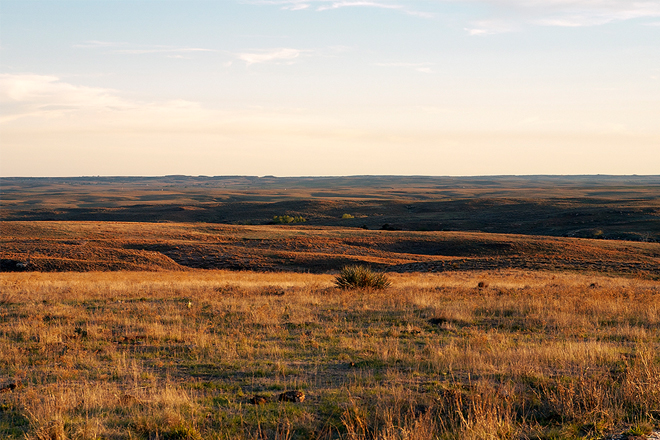
PRIVATE LANDS KEY
Over 95 percent of the land in the southern Great Plains is owned by farmers and ranchers — the economic mainstays for hundreds of rural communities. With nearly all its habitat under private ownership, conserving the lesser prairie chicken for future generations depends on voluntary actions by private landowners.
Pheasants Forever is partnering with the United States Department of Agriculture (USDA), local conservation groups and state resource agencies to work with landowners on putting in place practices that are mutually beneficial for these birds and for agricultural producers alike. Farm Bill biologists, cost-shared by PF, offer ranchers and farmers technical know-how for creating more productive and resilient grasslands.
“The range of the lesser prairie chicken also overlaps with several species of quail, and pheasants too, so our work to restore resilient prairie grasslands helps a whole host of upland birds,” says Jordan Menge, lesser prairie chicken coordinator for Pheasants Forever and Quail Forever.
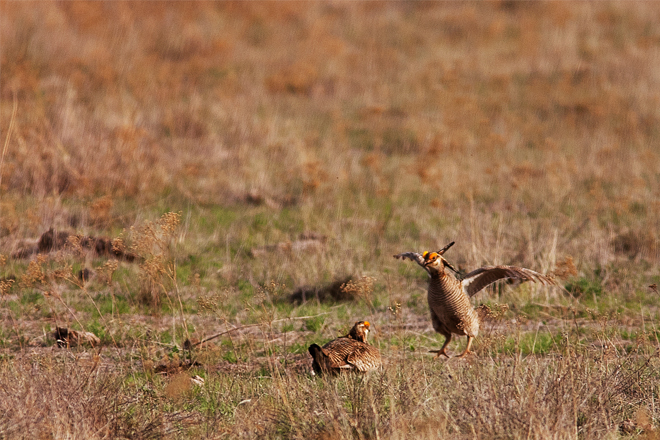
LESSER PRAIRIE CHICKEN INITIATIVE
Historically, natural disturbances such as frequent wildfires and grazing by bison herds helped maintain healthy prairie habitat. The removal of these large-scale forces from the Great Plains has led to a shift from grasslands to woodlands, which diminishes the productivity of the prairie for both wildlife and livestock.
Sustainable ranching activities can restore grasslands by helping deter invasive annual grasses (such as cheatgrass) and woody plants (such as red cedar or juniper) from taking over native prairie … and crowding out grouse.
Pheasants Forever is a key partner in the Lesser Prairie Chicken Initiative (LPCI), led by USDA’s Natural Resources Conservation Service (NRCS). LPCI works with ranchers to restore large blocks of prairie in the Southern Great Plains by: reintroducing fire to the landscape; rotating the timing and duration of livestock grazing to conserve native vegetation; and installing a host of other sustainable ranching practices.
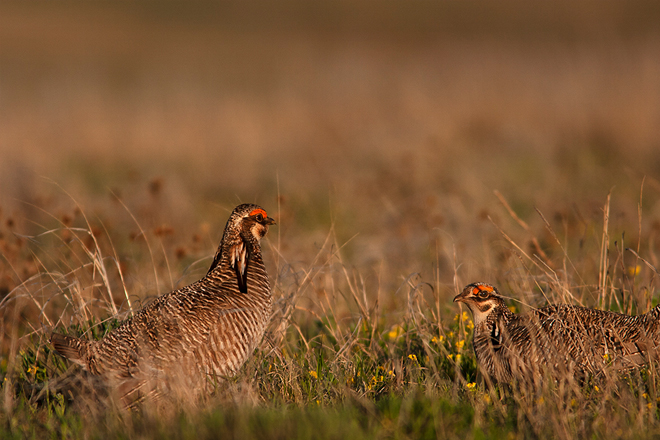
CRP MATTERS
Pheasants Forever also helps broaden landowner participation in USDA’s Conservation Reserve Program (CRP), which pays landowners to replant native vegetation on former crop lands to restore grasslands.
“Pheasants Forever has been a staunch advocate of USDA’s Conservation Reserve Program since its inception in 1985 because it helps us enact our mission to conserve upland bird populations through habitat improvements,” says Howard Vincent, president and CEO of Pheasants Forever.
A new study released from Bird Conservancy of the Rockies shows that these voluntary Farm Bill-funded programs do indeed work, and produce outcomes that matter. Lands enrolled in CRP or prescribed grazing programs produced 3 million more birds in the southern Great Plains, boosting populations of 24 species of grassland birds, 17 of which are in decline.
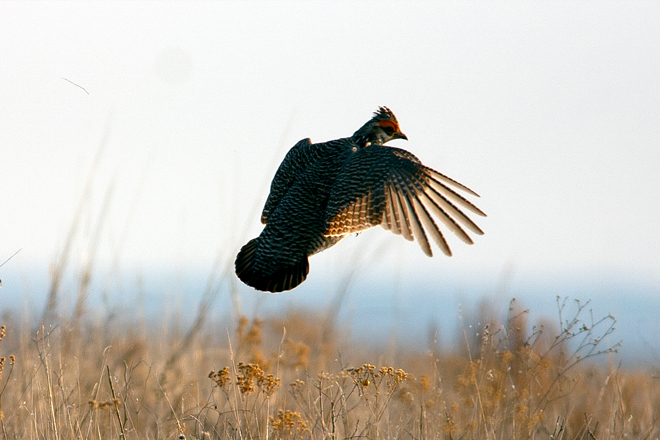
WORKSHOPS AND TOOLS
Pheasants Forever partners with NRCS and others to share research results like these in order to bridge the gap between science and on-the-ground implementation. That means hosting workshops that share the most recent research with ranchers and land managers so they can more effectively conserve habitat.
It also means creating easy-to-use tools (like the free online mapping application at rangelands.app) that allows people to track changes in natural resources over time. These science-based tools help partners quickly measure the results of past conservation work and plan future projects.
“Our goal is to measure the big-picture scientific outcomes from investing Farm Bill dollars to ensure conservation practices are successful and cost-efficient,” says Dr. David Naugle, science advisor for NRCS Working Lands for Wildlife, which includes the LPCI. “This science-based approach allows us to provide the biggest benefits for people and wildlife.”
Lesser Prairie Chickens By The Numbers
38,000 lesser prairie chickens estimated to remain today
83% decline in range-wide distribution
95% of habitat on private land in the southern Great Plains
1.6 million acres conserved via NRCS-led Lesser Prairie Chicken Initiative
800+ ranchers enrolled in LPCI
$42.6 million invested by NRCS Farm Bill programs since 2010
$14.2 million invested by conservation partners since 2010
This article originally appeared inthe Spring 2019 Issue of Pheasants Forever Journal.
Author Brianna Randall grew up in southern California but found herself in Montana and has never looked back.
Southern plainsman Chad Love is editor of Quail Forever Journal but is rumored to love boomers as much as bobs.